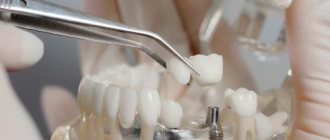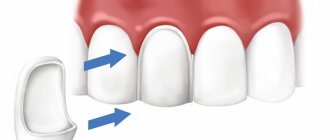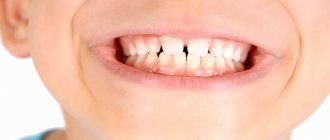Restoring a damaged tooth is a complex work aimed at preserving your dental unit and avoiding prosthetics or implantation. Modern dentistry offers a number of effective methods for treating a damaged tooth, even if only a two-millimeter root remains. In this material we will give answers to the most common questions regarding how to reliably restore a dental unit if it is more than half destroyed.
What teeth can be restored?
In dental practice, it is customary to consider those crowns that are missing more than 50% of their parts as a result of:
- carious lesion;
- mechanical injury;
- the presence of old fillings that do not collapse on their own, but caries develops underneath them;
- depulpation, against which the crown becomes fragile and changes color;
- increased abrasion of dentin, etc.
If you do not seek help from a dentist in time, restoring the unit will be problematic.
Pain after prosthetics
After installation of the orthopedic structure, the patient may experience pain. They are mainly caused by either adaptation of oral tissues to the elements of the prosthesis, or the development of inflammatory processes. Pain due to adaptation goes away on its own or after correction of the structure.
But pain after dental prosthetics, caused by inflammation, is fraught with dangerous consequences, so if they last longer than a few days, do not subside, but intensify, are accompanied by an unpleasant odor, the discharge of pus, it is urgent, without delay, to consult a doctor.
The cause of pain may be untreated foci of infection in the oral cavity, infection as a result of errors in the installation of the structure or previous preparatory operations, violation of the rules for using the prosthesis and oral hygiene, allergic reactions to the materials used in dental prosthetics, as well as too tight, or, conversely, , insufficiently tight fit of the prosthesis to the soft tissues.
In order to identify the causes of inflammation and cure it, it is necessary to contact a dental clinic, otherwise this can lead to breakage of the prosthesis, rejection of its structural elements and serious complications.
Is it possible to restore a damaged tooth?
Yes, you can. But everything will depend on the volume of the lost coronal part and the general condition of the oral cavity.
For restoration, modern dentists use the following two main methods:
- installation of pins (reinforcement) made of fiberglass or titanium;
- introduction of so-called stump inlays.
If more than 50% of the unit is destroyed, and the dentist has doubts that the crown restored with a stump or pin will not withstand the chewing load, a metal-ceramic crown is installed on the stump pin inlay. When restoring teeth, it is mandatory to clean and fill the canals to avoid the development of caries.
Correction of crooked teeth
As a rule, such a defect can be corrected using an artistic method only in case of minor deviations from the norm.
In case of protruding units, crowding or partial rotation, the patient is first sent to the orthodontist for a consultation. It is quite possible that the installation of braces or aligners will be initially recommended, and only after a course of treatment does it make sense to return to the issue of restoring aesthetics. Correction of malocclusion or dentition disorders can be successfully corrected at any age, including adults. Dentika specialists select the best option, taking into account the main task, the wishes of clients and the individual characteristics of the dental system. Modern dentistry carries out the restoration of front teeth in various ways, which allows restoration of any degree of complexity.
Light filling on a pin – what are the advantages of the method?
A post filling is considered a reliable replacement material when a dentist is restoring a fractured unit. A titanium or fiberglass pin is inserted into the root canal, after which the coronal part is restored with a composite material. Among the disadvantages of the method is the potential risk of root fracture, since the pin fails under pressure, as well as shrinkage of the filling and the development of secondary caries under it.
Unfortunately, teeth restored in this way do not last forever. After 3–5 years, the dentist will have to change the filling or, due to global destruction of the crown, perform prosthetics/implantation.
Why can't we leave everything as it is?
When a person loses a tooth in the smile area, he usually tries to restore it - but with chewing teeth that are not visible, the situation is different. Many people think that if one chewing tooth is lost, then nothing bad has happened - the rest are in place, which means they can chew.
Each tooth in our jaw carries an important functional, and not just aesthetic, load. If the tooth is not restored, negative consequences will inevitably occur:
- improper distribution of the chewing load will lead to gradual destruction of the teeth next to the defect - after all, they will have to work for themselves and for the lost tooth;
- bone tissue atrophy will occur due to the fact that there is no load during chewing;
- Bite defects will appear - if a tooth has been missing for years, then its row neighbors gradually begin to shift towards the empty space;
- chewing food will not be of sufficient quality, which over the years will lead to the development of problems with the gastrointestinal tract;
- bite defects will negatively affect the functioning of the temporomandibular joint, which will provoke neck pain, headaches, discomfort and pain when opening the mouth or chewing, even insomnia;
- Diction problems will appear.
How to restore a damaged tooth?
Treatment of a damaged tooth involves the following steps:
- examination by a dentist and assessment of further “future” damaged teeth;
- restoration of the stump area using a pin or inlay. The dentist treats the canals, strengthens the unit from the inside, thereby providing reliable support for the filling;
- The crown is built up using a composite material. If the work is done efficiently, the tooth can be visually almost indistinguishable from a natural one. The dentist repeats the shape, color and even transparency.
How much does restoration cost?
The price of the procedure is calculated individually. Clients of the Dentika clinic are offered favorable conditions; it is very popular when the patient is told the total amount, including preparation, cost of materials and the work of a specialist. In this case, there will be no changes, which is quite valuable over a long period of cooperation. It is worth considering that the most inexpensive procedure is a composite restoration; the installation of lumineers is included in the list of the most expensive manipulations.
What are the advantages and disadvantages of aesthetic dental correction?
The advantages are obvious - restoration of the dentition in the absence of individual units, correction of visible defects, beauty of the smile. It is also worth considering that almost all restoration procedures do not cause pain to the patient. Minor discomfort is allowed for people with hypersensitivity. If the issue of time is of fundamental importance, then it is worth choosing restoration with ceramics or composite; it can be carried out in 1-2 procedures, in contrast to installing a crown.
Disadvantages include the lack of treatment. This is a purely cosmetic manipulation, so first basic preparation is required, restoration, if necessary, installation of a pin and extension, and only then, as the final stage, the appearance is corrected. Also, if the patient’s list of habits includes smoking, a passion for coffee and alcohol, and a craving for chewing hard pieces of food, for example, nuts, then the service life of any plate or composite coating will be short-lived.
CONCLUSIONS:
As you can see from the examples provided, I, orthopedic dentist Sergei Samsakov, an expert in the field of digital modeling and restoration of teeth using Cerec, manage to restore a beautiful smile even in almost the most hopeless cases. If you have similar problems, do not hesitate, contact us, and we will always find the optimal and, most importantly, beautiful solution to your situation.
And remember the simple truth: there are no hopeless situations!
What to do if your tooth chipped?
See a dentist.
The doctor will remove the broken wall, take x-rays of the tooth, and evaluate its safety. If the tooth is not broken much, the root is not damaged or almost not damaged, then it can be restored. Then the tooth is prepared (if necessary, dental canals are treated, caries and old filling materials are cleaned), how badly it is damaged is assessed and the best way to restore it is selected (filling, inlay or crown). If the tooth cannot be saved, it is removed and replaced with an implant or other available method.
Injury
Single or chronic - the third reason for possible tooth chips
A single injury occurs when there is a blow, an accident, or accidentally biting on a hard object while chewing.
There are three types of chronic injury
- Due to malocclusion (when the teeth do not close correctly, some teeth may receive excessive load, close in the wrong areas, at the wrong angle, or with an opponent that is not their power). For example, a powerful fang of the lower jaw can be positioned in such a way that when closed, it will severely injure the incisor on the upper jaw, which is much inferior to it in size and power. As a result of such long-term closure, the incisor can get into big problems, and the patient will face the need for treatment or removal.
- Due to the absence of other teeth (when a number of teeth are missing, their work is performed by the remaining ones; excessive load may one day result in a fracture of the tooth, a break in its wall, or a split in the root).
- Due to bruxism (“idle” teeth grinding) or other parafunctional manifestations.
How to avoid?
- Be sure to restore missing teeth (there are a lot of ways today, there are even temporary prosthetics if for some reason you need to postpone dental treatment).
- Consult an orthodontist, orthopedist or periodontist about bite problems and undergo orthodontic treatment if indicated.
- Get advice from an orthopedist/gnathologist and psychotherapist about the possible causes of bruxism and take possible measures that the doctor recommends.
What to choose?
What to install if there is no root - a removable denture, a bridge or an implant? The dentist will select prosthetic options based on the condition of the oral cavity and the presence of relative or absolute contraindications. However, today doctors most often offer implant prosthetics. It has only two disadvantages compared to other types - a higher price and a longer period of prosthetics with several stages. However, this is compensated by excellent, long-term and predictable results. In addition, implantation technologies are constantly being improved; there are already techniques and implants that can significantly reduce the time of prosthetics.
Removable dentures
For centuries, dentists have been solving the problem: if there is no root, how to make a tooth? The first option, which has been around for thousands of years, is removable dentures. They were found during excavations of Egyptian tombs and in the territory of the Mayan Indians, so this is one of the most ancient methods of restoring teeth.
What are its advantages? Firstly, it is fast - making a prosthesis takes from 3 to 7 days, depending on the complexity of the work; secondly, it is inexpensive compared to bridges or implants. Modern materials for removable dentures make it possible to create structures similar to natural teeth, but they still have disadvantages:
- service life even with careful care is about 5–7 years;
- constant risk of prosthesis falling out and the need for additional fixation;
- the prosthesis does not stop bone atrophy;
- does not allow the chewing load to be evenly distributed;
- sometimes causes diction defects;
- there is a risk of allergies to acrylic, nylon, silicone and other materials.
Removable prosthetics are now being used if there are absolute contraindications to the installation of bridges or implants, or as a temporary measure while the patient waits for a permanent prosthesis to be made.
Examples of restoration of fifth teeth on the upper and lower jaws
Example 7. A metal tab and caries left only the root of the 5th tooth
A patient came to me with a 3.5 tooth. It was a pulpless tooth - the lower five, it did not have any periapical changes or inflammation in the area of the root apex. The tooth was missing the upper half of the crown part of the tooth. This tooth 3.5 initially had a filling, a metal stump insert was installed in the tooth, quite deep, and a filling was already installed on top. Here's a “puff sandwich”:
As I said in the previous example No. 6, metal tabs are beginning to be used less and less in practice - they have been replaced by modern computer technologies, for example, Cerec. As a result of the atraumatic removal of the metal insert, the bone was preserved, nothing cracked: neither the root nor the remaining bone structure:
The restoration of the bottom five was carried out using Cerec technology in 1.5 hours
:
The “crown + root” module fell into place perfectly, the patient was very pleased with such a quick and effective solution to his problem:
Example 8. The top five were completely destroyed by caries. But the tooth root survived
With this example, I want to show you how deep caries can literally “eat” your teeth. And, of course, try to prevent it from developing like this. The patient is a fairly young man who has decided to radically improve his image. This is a laudable decision, but here are the teeth he came to me with:
Caries on almost all teeth. After removing the carious layer, the remains of the teeth appeared in this form:
Please note that in place of the upper tooth 5
There was practically only one root left with a small side wall. In this case, the same technology of tooth restoration using the “crown + root” module and crowns/half-crowns with an inlay function was used. The result of the treatment, as they say, is on the face:
The goal of treatment, according to the patient, has been fully achieved - a brutal Man
:











